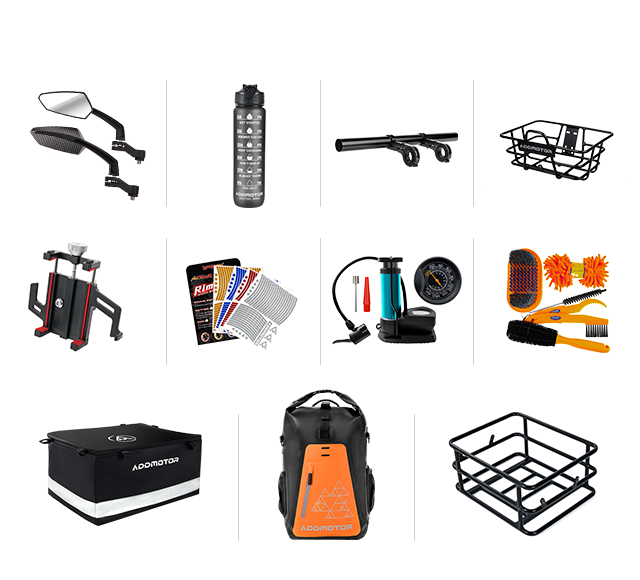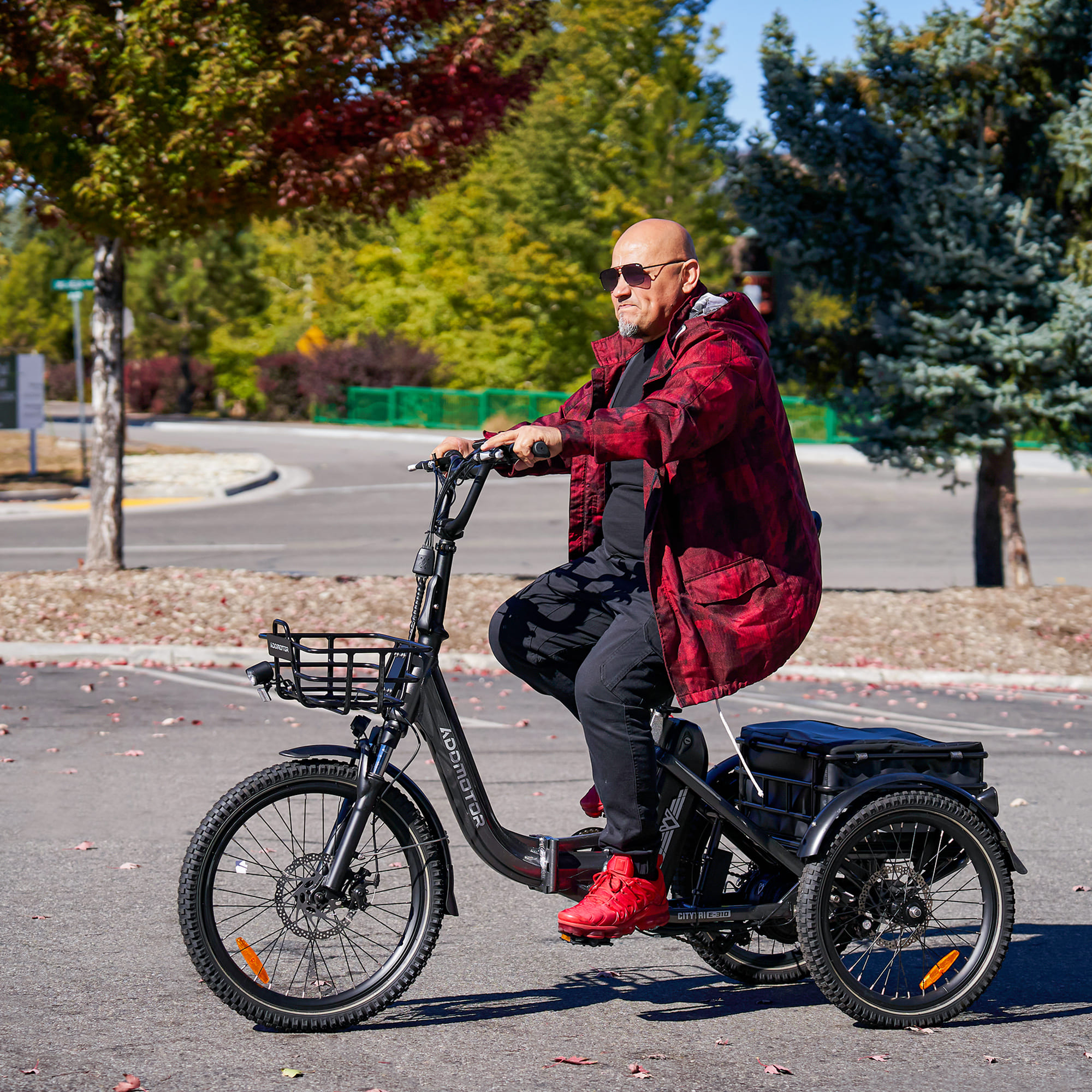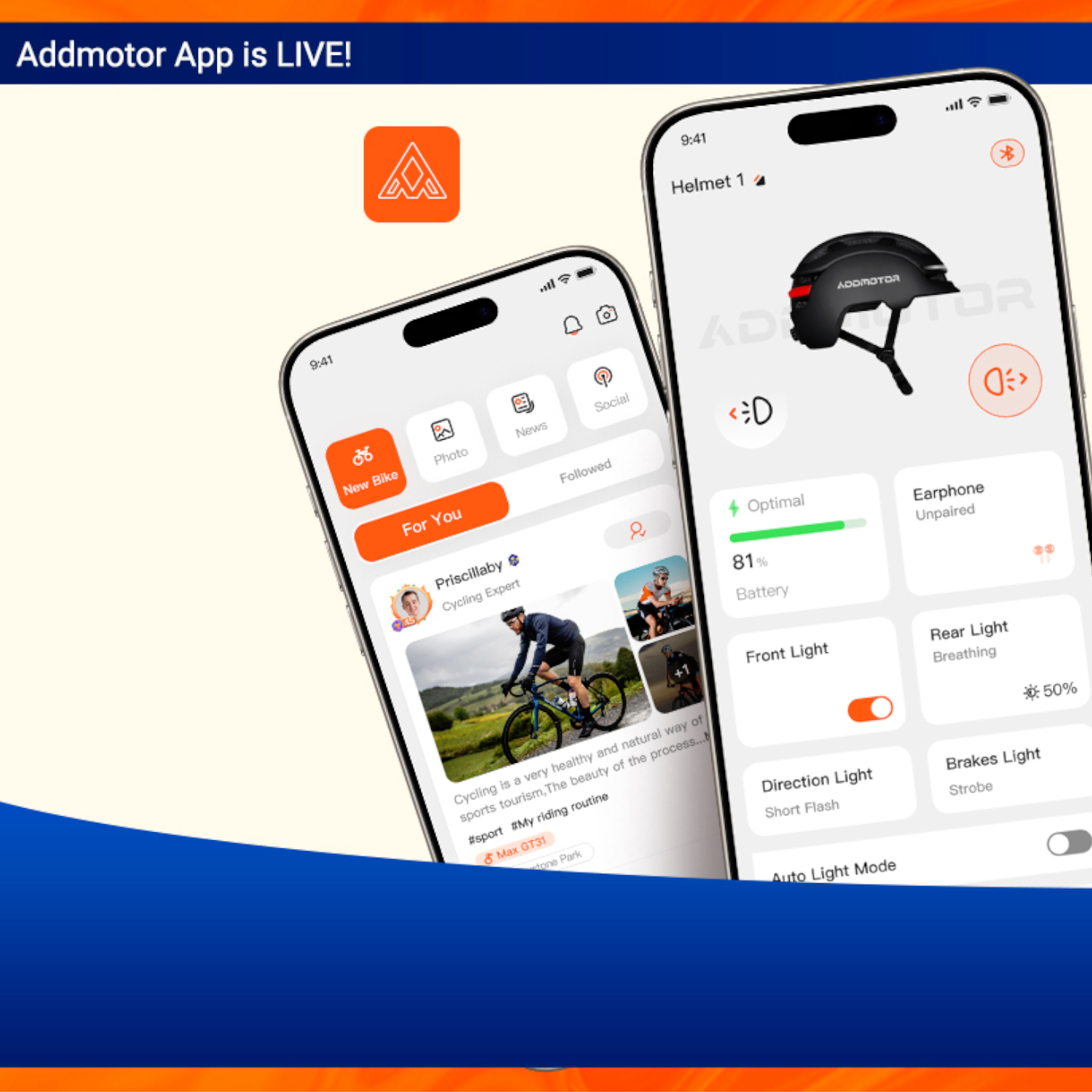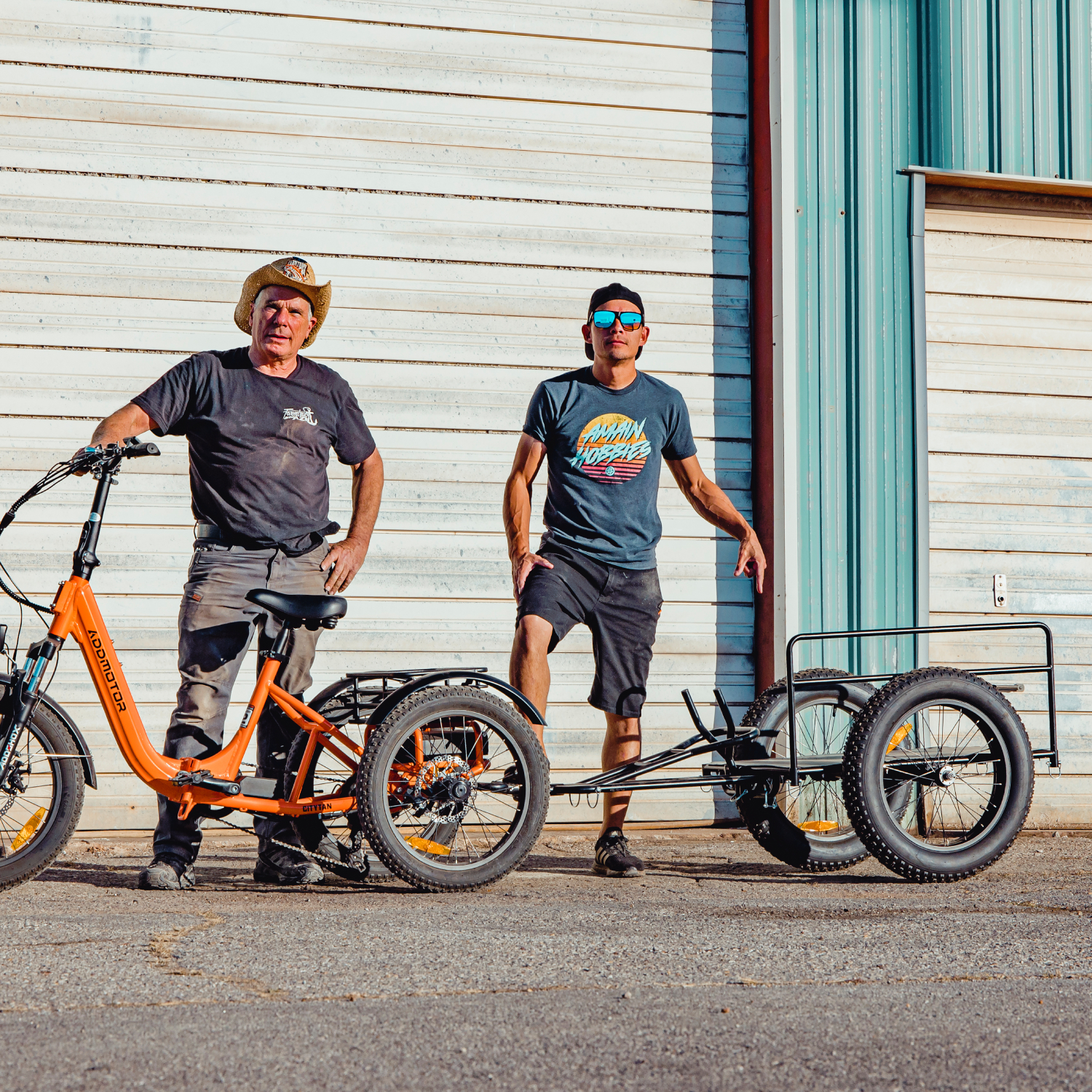The Ultimate Guide to Biking Safely with Your Dog: Tips for a Smooth Ride
By ADDMOTOR | 30 May 2025 | 0 Comments
Exploring the outdoors with your dog is a fantastic way to bond and stay active, but biking together comes with unique challenges that require extra attention. Unlike solo cycling, riding with your furry companion means considering their safety, behavior, and comfort at all times. Sudden movements, unexpected distractions, and changing terrain can pose risks if you're not properly prepared. This guide will help you navigate potential hazards and ensure a smooth, enjoyable ride by covering the best equipment, training tips, and planning strategies. With the right precautions, you and your pup can pedal confidently and create unforgettable outdoor adventures!
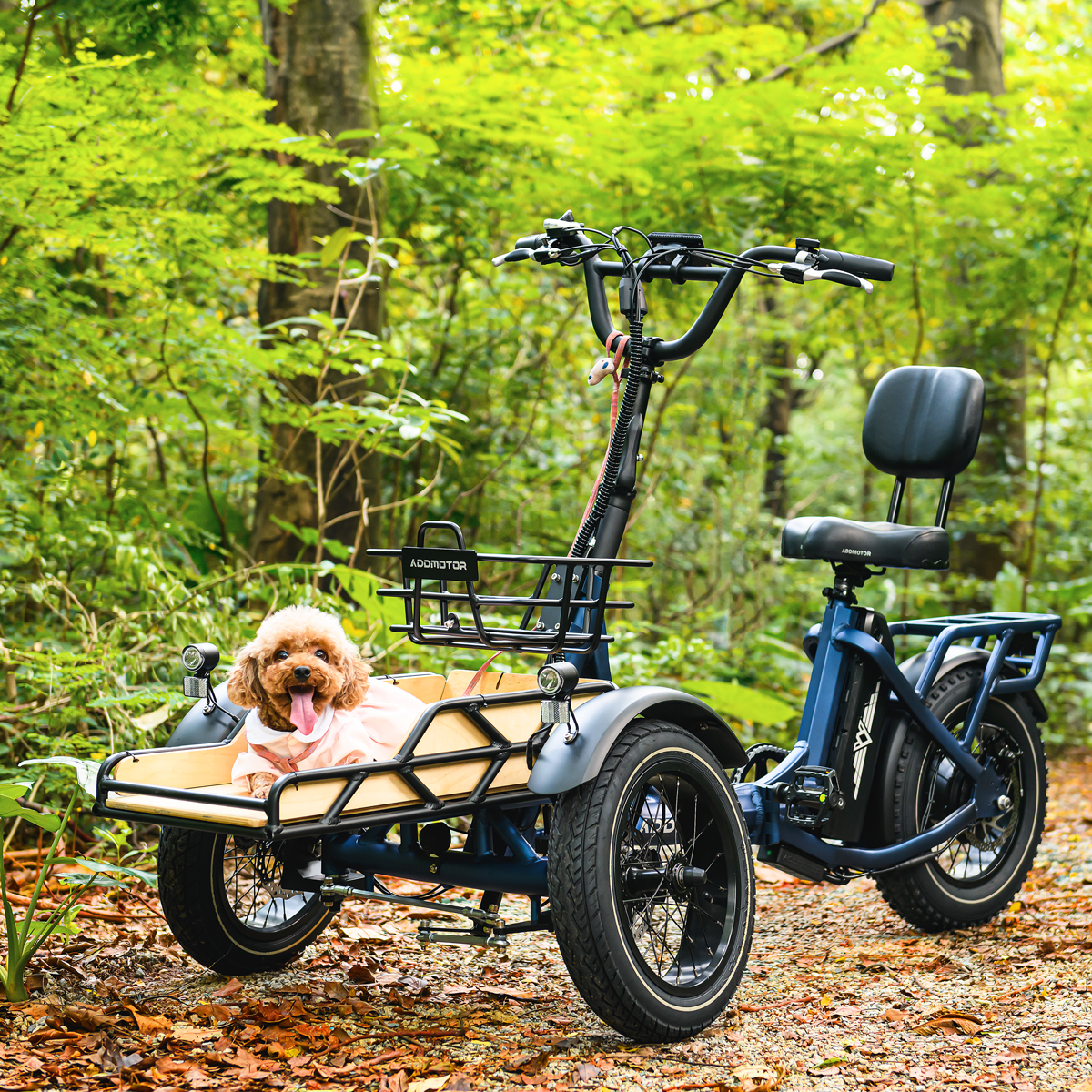
Leashes and Harnesses: Secure and Controlled Riding
Using a leash designed for biking helps prevent sudden tugs or unexpected dashes from your dog. A bungee-style leash is an excellent choice, as it absorbs shocks and provides a smoother ride. Pair it with a sturdy, well-fitted harness to ensure your dog's security without restricting their movement.
Why Consider an Addmotor 3-Wheel Electric trike?
If stability is a priority, a three-wheel electric trike like those from Addmotor can offer a safer experience, particularly for riders with dogs.
* Enhanced Balance: Unlike standard two-wheel trikes, three-wheel e-trikes provide extra stability, reducing the chances of tipping over.
* Dog-Friendly Design: Some models, such as the Grandtan M-340 electric trike, feature a spacious rear basket—perfect for storing pet essentials or even safely accommodating a small dog.
* Electric Assistance: A powerful 750W motor and front suspension system allow riders to cover longer distances with ease—ideal for seniors or anyone who prefers a more relaxed biking experience.
Additional Safety Gear for Your Dog
Beyond a leash and harness, consider these safety essentials:
* Reflective Gear & LED Lights: Improve visibility during evening rides, ensuring other cyclists and vehicles can spot your dog easily.
* Protective Boots: Shield their paws from hot pavement, rough terrain, or sharp debris, making every ride more comfortable.
By equipping yourself and your dog with the right gear, you’re taking the necessary steps to make biking safer and more enjoyable.
Introducing Your Dog to the etrike: Start Slow and Build Confidence
Before hitting the road, allow your dog to become familiar with the etrike while it’s stationary. Let them sniff, explore, and walk beside it to ease any uncertainty. Then, gradually increase movement—starting with short, slow walks while holding the e trike and eventually progressing to a light jog before attempting full rides. This step-by-step approach helps your dog gain confidence and understand how biking works.
Teaching Essential Commands for Biking Safety
To maintain control and ensure a secure ride, your dog should respond to basic biking commands, such as:
* “Stay close” – Keeps your dog at a steady pace beside the electric trike, preventing sudden pulling or distractions.
* “Stop” – Signals an immediate halt for safety, preventing accidents at crosswalks, intersections, or unexpected obstacles.
Consistent training and positive reinforcement will help reinforce these commands, ensuring a smoother ride each time.
Is Your Dog a Good Fit for Biking?
While many dogs enjoy running alongside trikes, some breeds are particularly well-suited for biking due to their stamina, energy levels, and trainability.
* Best breeds for biking: Border Collies, Labrador Retrievers, Australian Shepherds—known for their endurance and ability to follow commands.
* Dogs that may struggle: Older dogs or those with joint issues may not be ideal biking companions, as the activity can strain their mobility.
By assessing your dog’s fitness level, temperament, and breed characteristics, you can determine whether biking is a safe and enjoyable option for them. Always prioritize their comfort and well-being, and remember—your dog’s needs come first on every ride.
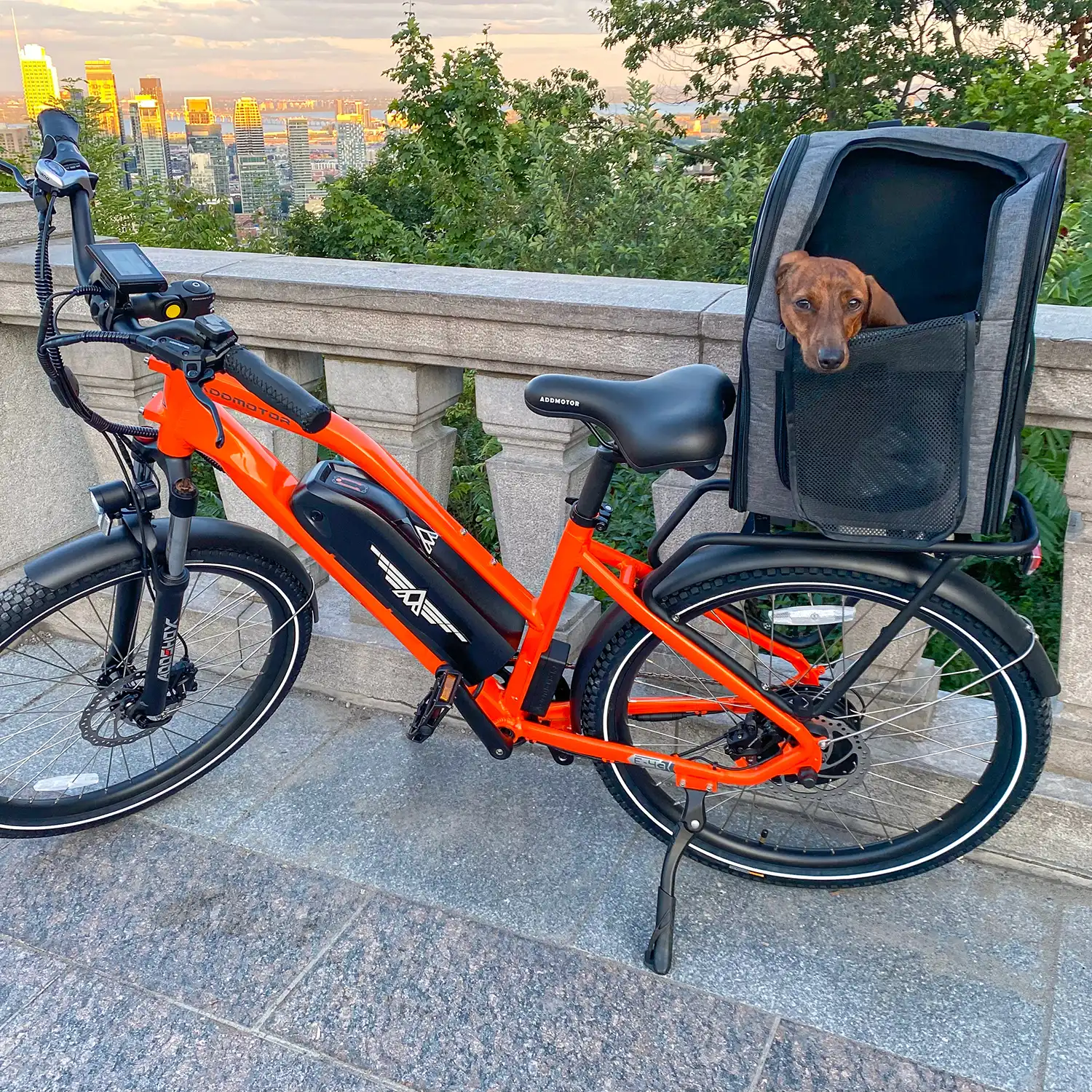
Selecting the right biking path plays a crucial role in ensuring both safety and enjoyment for you and your furry companion. A well-planned route minimizes risks while making the experience more relaxing and enjoyable.
Avoid Busy Roads: Prioritize Safety and Comfort
Crowded streets with fast-moving vehicles can create unnecessary stress and danger for both you and your dog. Instead, consider these safer alternatives:
* Paved trails in parks – Smooth surfaces offer a comfortable ride with fewer hazards.
* Nature paths with minimal distractions – Ideal for dogs that may be easily startled by traffic noise or crowds.
* Dog-friendly biking areas – Some parks and trails are specifically designed to accommodate cyclists and their pets.
Considering the Weather: Adjusting Your Ride for Safety
Weather conditions can impact your dog’s well-being, so planning accordingly is essential.
* Hot weather precautions – Schedule rides during early mornings or late evenings to avoid excessive heat and reduce the risk of overheating.
* Cold weather safety – Inspect road surfaces for ice or slippery spots before heading out to prevent injuries from sudden slips or falls.
By choosing safe and scenic routes, you enhance both the safety and overall biking experience, making every adventure enjoyable for you and your dog.
Finding the Right Speed: Keep a Comfortable Pace
Dogs have different stamina levels, so it's crucial to match your riding speed to their natural pace. Avoid sudden speed changes, as abrupt shifts can cause them to trip, strain their muscles, or struggle to keep up. A steady, predictable rhythm will help your dog run alongside the trike safely and comfortably.
Using an Addmotor Electric Trike for a Smoother Ride
Electric trikes can make biking with your dog easier, but proper speed control is essential for safety.
* Choose a gentle riding mode – Select a lower-speed setting that allows your dog to maintain a comfortable pace.
* Be mindful of acceleration – Electric trikes pick up speed quickly, so always adjust gradually to prevent your dog from getting overwhelmed.
Watching for Signs of Fatigue: Know When to Pause
Your dog's energy levels will vary depending on weather conditions, terrain, and overall fitness. Look for signs that indicate they need a break, such as:
* Slower pace or frequent stopping
* Heavy panting or excessive drooling
* Unwillingness to continue running
If you notice these signs, pause the ride, offer water, and give your dog time to rest before continuing. Prioritizing their well-being will keep biking a positive experience for both of you.
Water and Snacks: Preventing Dehydration
Dogs can quickly become dehydrated, especially in warm weather. To keep your pup refreshed and energized:
* Carry a portable pet water bottle – Easy-access hydration ensures your dog stays cool and comfortable throughout the ride.
* Offer water frequently – Encourage small sips every 15–20 minutes, especially on warm days or during strenuous activity.
* Pack light snacks – Healthy treats provide extra energy, particularly for longer rides where stamina may be tested.
Resting and Recharging: Prioritizing Breaks
A well-timed break can make a significant difference in your dog’s endurance.
* Pause every 20–30 minutes – Check in on your dog’s energy levels and offer a few minutes of downtime.
* Monitor for signs of fatigue – If your dog seems sluggish, overheated, or reluctant to continue, stop for a longer rest period.
* Choose shaded spots for breaks – Keeping your dog cool helps prevent overheating, especially in warmer climates.
By ensuring regular hydration and rest, you’ll help your dog stay comfortable and energized, making every biking adventure safe and enjoyable.

When a Dog is Overly Excited or Nervous Around trikes
If your dog seems anxious or overly enthusiastic, easing them into the biking experience can help build confidence and reduce stress. Try these strategies:
* Offer treats near the trike – Positive reinforcement helps create a friendly association with the trike, making it less intimidating.
* Walk alongside a stationary trike – Before riding, practice short walks with your dog next to the trike to familiarize them with its presence.
* Gradual exposure – Increase movement slowly, allowing your dog time to adjust before progressing to full rides.
Getting Your Dog Comfortable with an Electric Trike
Electric trikes introduce additional elements, such as motor noise and varying speeds, which some dogs may find unsettling. To help your dog adjust:
* Start with short rides in quiet areas – Reduce exposure to loud environments and let your dog get accustomed to the trike’s sound and movement.
* Gradual speed adjustments – Avoid sudden acceleration, allowing your dog to keep up at a steady pace.
* Consistent reassurance – Use calming words and positive reinforcement to encourage confidence.
Whether you choose a traditional bicycle or opt for the stability of an Addmotor 3-wheel electric trike, prioritizing your dog’s comfort and well-being should always come first. By taking the time to prepare, adjust to your dog’s needs, and follow safe riding practices, you’ll set the foundation for countless enjoyable adventures.
Embrace the journey, stay mindful of your dog’s limits, and make every ride a memorable experience.

1. Choosing the Right Gear: Prioritizing Safety for You and Your Dog
Before setting off on a ride, investing in the right equipment can make all the difference in ensuring a safe and enjoyable experience for both you and your furry companion. Biking with a dog requires extra attention, as unexpected movements or distractions can quickly turn into hazards. Proper gear minimizes risks and keeps your pup comfortable throughout the journey.Leashes and Harnesses: Secure and Controlled Riding
Using a leash designed for biking helps prevent sudden tugs or unexpected dashes from your dog. A bungee-style leash is an excellent choice, as it absorbs shocks and provides a smoother ride. Pair it with a sturdy, well-fitted harness to ensure your dog's security without restricting their movement.
Why Consider an Addmotor 3-Wheel Electric trike?
If stability is a priority, a three-wheel electric trike like those from Addmotor can offer a safer experience, particularly for riders with dogs.
* Enhanced Balance: Unlike standard two-wheel trikes, three-wheel e-trikes provide extra stability, reducing the chances of tipping over.
* Dog-Friendly Design: Some models, such as the Grandtan M-340 electric trike, feature a spacious rear basket—perfect for storing pet essentials or even safely accommodating a small dog.
* Electric Assistance: A powerful 750W motor and front suspension system allow riders to cover longer distances with ease—ideal for seniors or anyone who prefers a more relaxed biking experience.
Additional Safety Gear for Your Dog
Beyond a leash and harness, consider these safety essentials:
* Reflective Gear & LED Lights: Improve visibility during evening rides, ensuring other cyclists and vehicles can spot your dog easily.
* Protective Boots: Shield their paws from hot pavement, rough terrain, or sharp debris, making every ride more comfortable.
By equipping yourself and your dog with the right gear, you’re taking the necessary steps to make biking safer and more enjoyable.
2. Training Your Dog to trike Alongside You: Setting Up for a Safe and Enjoyable Ride
Not every dog is naturally suited for biking, so proper training is essential to ensure a smooth, safe experience. By taking the time to introduce your pup to the etrike and reinforcing important commands, you can minimize risks and create an enjoyable biking routine that works for both of you.Introducing Your Dog to the etrike: Start Slow and Build Confidence
Before hitting the road, allow your dog to become familiar with the etrike while it’s stationary. Let them sniff, explore, and walk beside it to ease any uncertainty. Then, gradually increase movement—starting with short, slow walks while holding the e trike and eventually progressing to a light jog before attempting full rides. This step-by-step approach helps your dog gain confidence and understand how biking works.
Teaching Essential Commands for Biking Safety
To maintain control and ensure a secure ride, your dog should respond to basic biking commands, such as:
* “Stay close” – Keeps your dog at a steady pace beside the electric trike, preventing sudden pulling or distractions.
* “Stop” – Signals an immediate halt for safety, preventing accidents at crosswalks, intersections, or unexpected obstacles.
Consistent training and positive reinforcement will help reinforce these commands, ensuring a smoother ride each time.
Is Your Dog a Good Fit for Biking?
While many dogs enjoy running alongside trikes, some breeds are particularly well-suited for biking due to their stamina, energy levels, and trainability.
* Best breeds for biking: Border Collies, Labrador Retrievers, Australian Shepherds—known for their endurance and ability to follow commands.
* Dogs that may struggle: Older dogs or those with joint issues may not be ideal biking companions, as the activity can strain their mobility.
By assessing your dog’s fitness level, temperament, and breed characteristics, you can determine whether biking is a safe and enjoyable option for them. Always prioritize their comfort and well-being, and remember—your dog’s needs come first on every ride.
3. Choosing Safe and Scenic Routes for Biking with Your Dog

Selecting the right biking path plays a crucial role in ensuring both safety and enjoyment for you and your furry companion. A well-planned route minimizes risks while making the experience more relaxing and enjoyable.
Avoid Busy Roads: Prioritize Safety and Comfort
Crowded streets with fast-moving vehicles can create unnecessary stress and danger for both you and your dog. Instead, consider these safer alternatives:
* Paved trails in parks – Smooth surfaces offer a comfortable ride with fewer hazards.
* Nature paths with minimal distractions – Ideal for dogs that may be easily startled by traffic noise or crowds.
* Dog-friendly biking areas – Some parks and trails are specifically designed to accommodate cyclists and their pets.
Considering the Weather: Adjusting Your Ride for Safety
Weather conditions can impact your dog’s well-being, so planning accordingly is essential.
* Hot weather precautions – Schedule rides during early mornings or late evenings to avoid excessive heat and reduce the risk of overheating.
* Cold weather safety – Inspect road surfaces for ice or slippery spots before heading out to prevent injuries from sudden slips or falls.
By choosing safe and scenic routes, you enhance both the safety and overall biking experience, making every adventure enjoyable for you and your dog.
4. Staying Safe While Riding: Prioritizing Your Dog’s Comfort and Well-Being
Ensuring a safe ride goes beyond choosing the right gear—it’s also about maintaining the right speed, monitoring your dog’s condition, and using smart biking techniques. Being mindful of your dog’s limits will help prevent accidents and make every ride enjoyable.Finding the Right Speed: Keep a Comfortable Pace
Dogs have different stamina levels, so it's crucial to match your riding speed to their natural pace. Avoid sudden speed changes, as abrupt shifts can cause them to trip, strain their muscles, or struggle to keep up. A steady, predictable rhythm will help your dog run alongside the trike safely and comfortably.
Using an Addmotor Electric Trike for a Smoother Ride
Electric trikes can make biking with your dog easier, but proper speed control is essential for safety.
* Choose a gentle riding mode – Select a lower-speed setting that allows your dog to maintain a comfortable pace.
* Be mindful of acceleration – Electric trikes pick up speed quickly, so always adjust gradually to prevent your dog from getting overwhelmed.
Watching for Signs of Fatigue: Know When to Pause
Your dog's energy levels will vary depending on weather conditions, terrain, and overall fitness. Look for signs that indicate they need a break, such as:
* Slower pace or frequent stopping
* Heavy panting or excessive drooling
* Unwillingness to continue running
If you notice these signs, pause the ride, offer water, and give your dog time to rest before continuing. Prioritizing their well-being will keep biking a positive experience for both of you.
5. Taking Breaks and Keeping Your Dog Hydrated
Long trike rides can be physically demanding for your dog, so planning regular breaks is essential for their comfort and well-being. Hydration and rest help prevent exhaustion and keep the ride enjoyable.Water and Snacks: Preventing Dehydration
Dogs can quickly become dehydrated, especially in warm weather. To keep your pup refreshed and energized:
* Carry a portable pet water bottle – Easy-access hydration ensures your dog stays cool and comfortable throughout the ride.
* Offer water frequently – Encourage small sips every 15–20 minutes, especially on warm days or during strenuous activity.
* Pack light snacks – Healthy treats provide extra energy, particularly for longer rides where stamina may be tested.
Resting and Recharging: Prioritizing Breaks
A well-timed break can make a significant difference in your dog’s endurance.
* Pause every 20–30 minutes – Check in on your dog’s energy levels and offer a few minutes of downtime.
* Monitor for signs of fatigue – If your dog seems sluggish, overheated, or reluctant to continue, stop for a longer rest period.
* Choose shaded spots for breaks – Keeping your dog cool helps prevent overheating, especially in warmer climates.
By ensuring regular hydration and rest, you’ll help your dog stay comfortable and energized, making every biking adventure safe and enjoyable.

6. Common Challenges and Solutions: Ensuring a Smooth Biking Experience
Biking with a dog can present unique challenges, especially if they are overly excited, nervous, or unfamiliar with trikes. Understanding these obstacles and using gradual training techniques will help create a safe and enjoyable ride.When a Dog is Overly Excited or Nervous Around trikes
If your dog seems anxious or overly enthusiastic, easing them into the biking experience can help build confidence and reduce stress. Try these strategies:
* Offer treats near the trike – Positive reinforcement helps create a friendly association with the trike, making it less intimidating.
* Walk alongside a stationary trike – Before riding, practice short walks with your dog next to the trike to familiarize them with its presence.
* Gradual exposure – Increase movement slowly, allowing your dog time to adjust before progressing to full rides.
Getting Your Dog Comfortable with an Electric Trike
Electric trikes introduce additional elements, such as motor noise and varying speeds, which some dogs may find unsettling. To help your dog adjust:
* Start with short rides in quiet areas – Reduce exposure to loud environments and let your dog get accustomed to the trike’s sound and movement.
* Gradual speed adjustments – Avoid sudden acceleration, allowing your dog to keep up at a steady pace.
* Consistent reassurance – Use calming words and positive reinforcement to encourage confidence.
7. Final Thoughts: Creating Safe and Enjoyable Biking Adventures with Your Dog
Biking with your dog is more than just a way to stay active—it’s an opportunity to strengthen your bond and explore the outdoors together. With proper training, the right equipment, and thoughtful safety precautions, you can ensure every ride is both fun and secure.Whether you choose a traditional bicycle or opt for the stability of an Addmotor 3-wheel electric trike, prioritizing your dog’s comfort and well-being should always come first. By taking the time to prepare, adjust to your dog’s needs, and follow safe riding practices, you’ll set the foundation for countless enjoyable adventures.
Embrace the journey, stay mindful of your dog’s limits, and make every ride a memorable experience.
Leave a Reply
Your email address will not be published.Required fields are marked. *
Latest Stories

